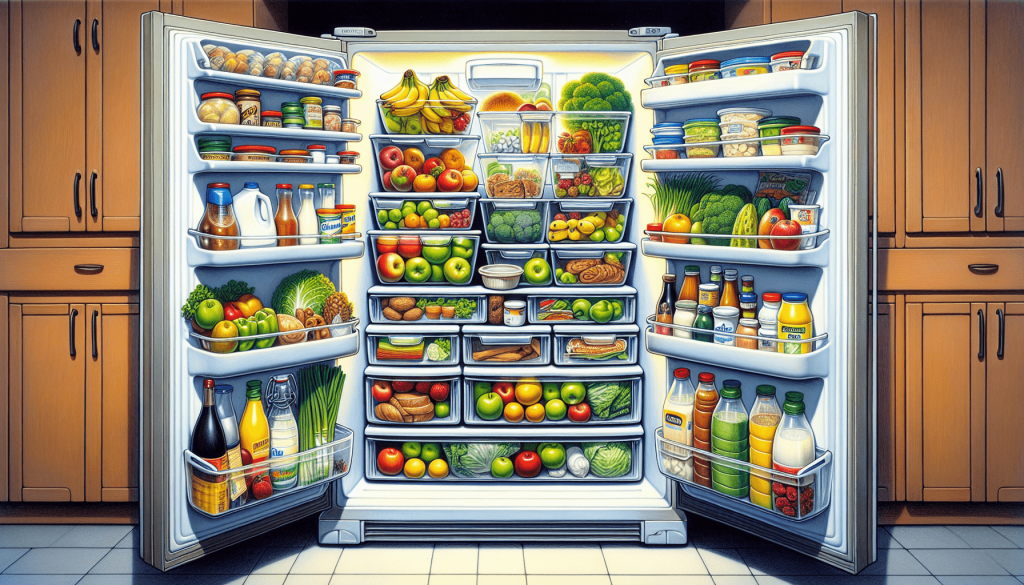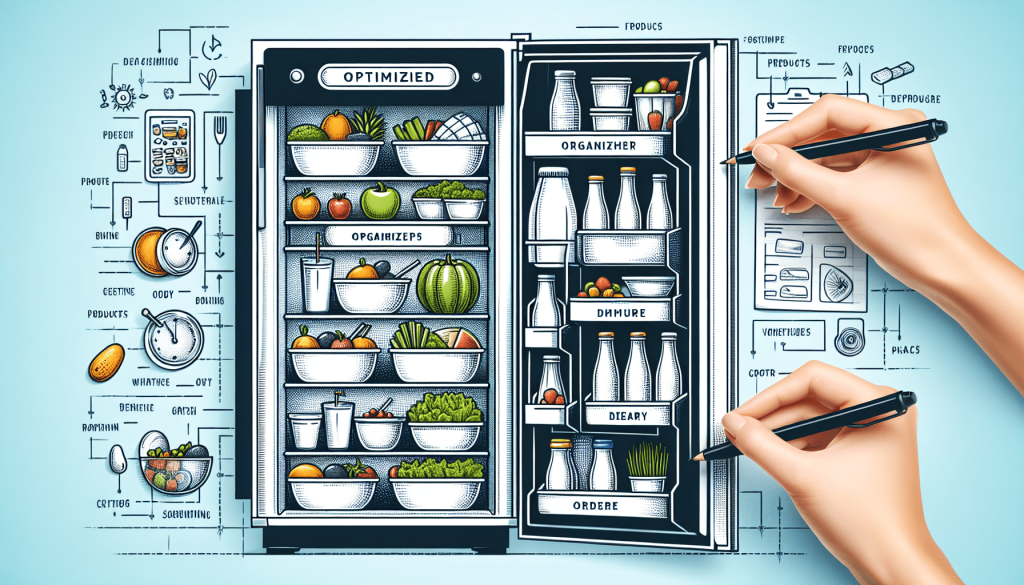If you’ve ever opened your fridge and been greeted with a chaotic mess of food items, then it might be time to bring some order to the chaos. In this article, we will guide you through some simple steps for organizing your fridge, making it easier to find what you need and keeping everything fresh for longer. From creating designated zones to utilizing clever storage solutions, these tips will transform your fridge into a tidy and efficient space. So, say goodbye to the frustration of searching for that elusive jar of pickles and hello to a well-organized fridge that will make meal prepping a breeze. Let’s get started!

Clearing out and cleaning
One of the first steps in organizing your fridge is to clear out all of the items. Take everything out and assess each item individually. Dispose of any expired or spoiled items to make space for the fresh ones. Once the fridge is empty, it’s time to clean. Use warm soapy water to clean the shelves and drawers, making sure to remove any stains or spills. After cleaning, dry the surfaces thoroughly to prevent any residue or moisture from accumulating.
Categorizing food
To make your fridge more organized and easier to navigate, it’s important to group similar items together. This will not only help you find what you need quickly but also prevent any cross-contamination. Use clear containers to store items, as they provide better visibility and allow you to see what’s inside without having to search. To make identification even easier, consider labelling the containers with their contents. Additionally, assign specific zones in your fridge for different food categories, such as dairy, fruits and vegetables, meats, and leftovers. This way, you’ll always know where to find what you need.
Maximizing space
When organizing your fridge, it’s important to make the most of the available space. One way to do this is by using stackable containers or bins. These help save vertical space and make it easier to access items at the back of the fridge. Utilize the door shelves for condiments and beverages, as these spaces are often underutilized. Place taller items towards the back of the shelves to maximize visibility and ensure that everything is easily accessible. If needed, adjust the shelves to accommodate larger items, such as bottles or tall containers.
Maintaining proper temperature
To keep your food fresh and safe, it’s crucial to maintain the appropriate temperature in your fridge. Set the temperature between 3-5 degrees Celsius to ensure the optimal storage conditions for most foods. It’s also a good idea to keep a fridge thermometer inside to monitor the temperature regularly. Avoid placing items directly in front of air vents, as this can obstruct the airflow and disrupt the cooling process. To promote proper airflow, make sure there is ample space between items and avoid overcrowding the fridge.

Organizing the freezer
Organizing your freezer is just as important as organizing your fridge. Start by sorting frozen food into categories, such as meats, vegetables, and desserts. This will make it easier to find what you need without having to dig through the freezer. Use freezer-safe containers or bags to store leftovers or pre-cooked meals, ensuring that they are properly sealed to prevent freezer burn. To keep track of freshness, label each item with the date it was frozen. For added convenience, consider creating an inventory list of the items in your freezer to quickly reference what you have in stock.
Creating a cleaning schedule
To maintain a clean and organized fridge, it’s essential to establish a regular cleaning routine. Plan to thoroughly clean the fridge every few months to remove any lingering odours or spills. In addition to deep cleaning, it’s important to perform regular maintenance tasks. Set reminders or alarms on your phone to remind you of these tasks, such as wiping spills, checking for expired items, and restocking food supplies. Make it a family affair and involve other household members in the cleaning process to lighten the load and make it a fun activity.
Utilizing fridge organization tools
There are several organizational tools available that can help optimize the space in your fridge. Consider using fridge mats or liners to protect the shelves from spills or stains. These can be easily removed and cleaned, saving you time and effort. Invest in clear storage bins with handles, as they make it easier to retrieve and transport items from the fridge. Magnetic spice racks or hooks can be attached to the fridge walls to free up shelf space and provide easy access to commonly used items. For items that are frequently used but take up space, consider using lazy susans to rotate and access them effortlessly.
Preventing food wastage
One of the advantages of organizing your fridge is that it can help prevent food wastage. Before purchasing groceries, always check the expiration dates to ensure the items have a longer shelf life. When storing food, practice the “first in, first out” rule by placing older items towards the front so that they are used first. Planning meals and creating a shopping list based on what you truly need can also help avoid excess purchases and potential food waste. If you have leftovers or unused ingredients, freezing them can extend their shelf life and prevent them from going to waste.
Managing leftovers
Leftovers are a common occurrence in most households and can quickly clutter the fridge. To keep them organized, designate a specific shelf or section for leftovers. Use transparent containers to store them, allowing you to easily identify what’s inside without having to open each container. It’s important to label leftovers with the date they were stored to track their freshness and prevent them from being forgotten. Regularly check the designated shelf or section and dispose of older leftovers to make space for fresh ones.
Regular maintenance and organization
Apart from regular cleaning, there are other maintenance tasks that can help keep your fridge organized. Wipe spills and stains immediately to prevent them from hardening or causing unpleasant odours. Check and adjust the fridge settings regularly to ensure that the temperature is consistent and within the recommended range. Consider reorganizing the fridge every few weeks to keep it in order and optimize the use of space. Lastly, monitor and restock food items to prevent running out of essentials and maintain a well-stocked and organized fridge.
By following these simple steps, you can transform your fridge into an organized and efficient space. Not only will you save time and effort when searching for items, but you’ll also reduce food waste and extend the shelf life of your groceries. Remember to involve other household members in the cleaning and organization process to make it a collaborative effort. With a well-organized fridge, you’ll have a stress-free cooking experience and enjoy the benefits of a tidy kitchen.
